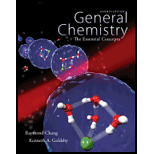
Concept explainers
(a)
Interpretation: Name and
To write name and symbol of an element in group 1A
(b)
Interpretation:
Name and symbol for one element in each of the given groups have to be written.
To write name and symbol of an element in group 2A
(c)
Interpretation:
Name and symbol for one element in each of the given groups have to be written.
To write name and symbol of an element in group 3A
(d)
Interpretation: Name and symbol for one element in each of the given groups have to be written.
To write name and symbol of an element in group 4A
(e)
Interpretation: Name and symbol for one element in each of the given groups have to be written.
To write name and symbol of an element in group 5A
(f)
Interpretation: Name and symbol for one element in each of the given groups have to be written.
To write name and symbol of an element in group 6A
(g)
Interpretation: Name and symbol for one element in each of the given groups have to be written.
To write name and symbol of an element in group 7A
(h)
Interpretation: Name and symbol for one element in each of the given groups have to be written.
To write name and symbol of an element in group 8A
Want to see the full answer?
Check out a sample textbook solution
Chapter 8 Solutions
Workbook with Solutions to Accompany General Chemistry
 ChemistryChemistryISBN:9781305957404Author:Steven S. Zumdahl, Susan A. Zumdahl, Donald J. DeCostePublisher:Cengage Learning
ChemistryChemistryISBN:9781305957404Author:Steven S. Zumdahl, Susan A. Zumdahl, Donald J. DeCostePublisher:Cengage Learning ChemistryChemistryISBN:9781259911156Author:Raymond Chang Dr., Jason Overby ProfessorPublisher:McGraw-Hill Education
ChemistryChemistryISBN:9781259911156Author:Raymond Chang Dr., Jason Overby ProfessorPublisher:McGraw-Hill Education Principles of Instrumental AnalysisChemistryISBN:9781305577213Author:Douglas A. Skoog, F. James Holler, Stanley R. CrouchPublisher:Cengage Learning
Principles of Instrumental AnalysisChemistryISBN:9781305577213Author:Douglas A. Skoog, F. James Holler, Stanley R. CrouchPublisher:Cengage Learning Organic ChemistryChemistryISBN:9780078021558Author:Janice Gorzynski Smith Dr.Publisher:McGraw-Hill Education
Organic ChemistryChemistryISBN:9780078021558Author:Janice Gorzynski Smith Dr.Publisher:McGraw-Hill Education Chemistry: Principles and ReactionsChemistryISBN:9781305079373Author:William L. Masterton, Cecile N. HurleyPublisher:Cengage Learning
Chemistry: Principles and ReactionsChemistryISBN:9781305079373Author:William L. Masterton, Cecile N. HurleyPublisher:Cengage Learning Elementary Principles of Chemical Processes, Bind...ChemistryISBN:9781118431221Author:Richard M. Felder, Ronald W. Rousseau, Lisa G. BullardPublisher:WILEY
Elementary Principles of Chemical Processes, Bind...ChemistryISBN:9781118431221Author:Richard M. Felder, Ronald W. Rousseau, Lisa G. BullardPublisher:WILEY





